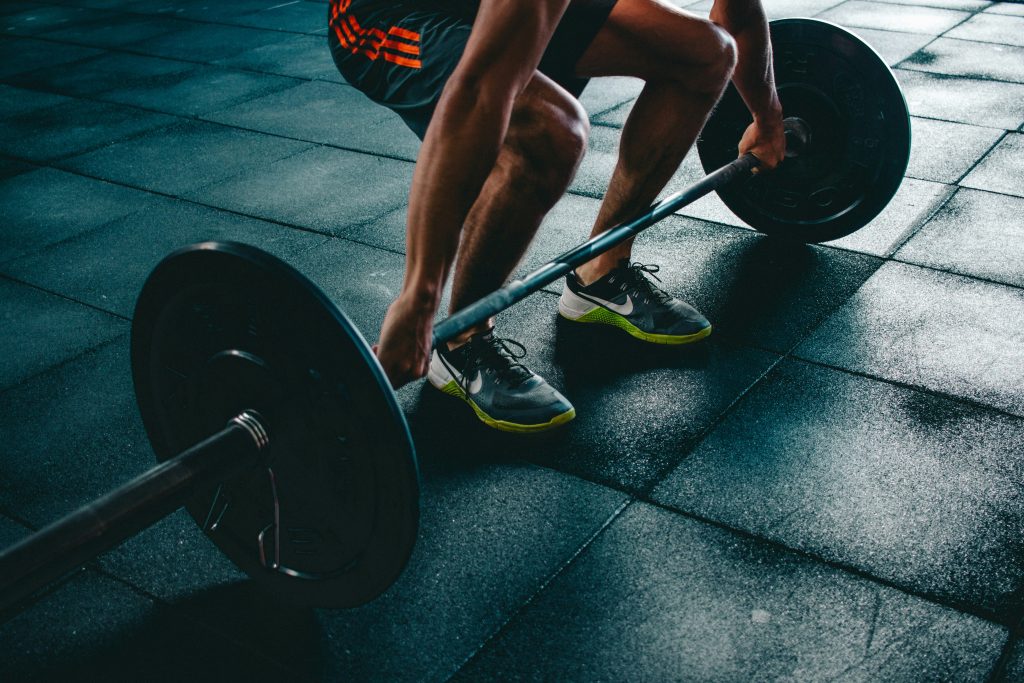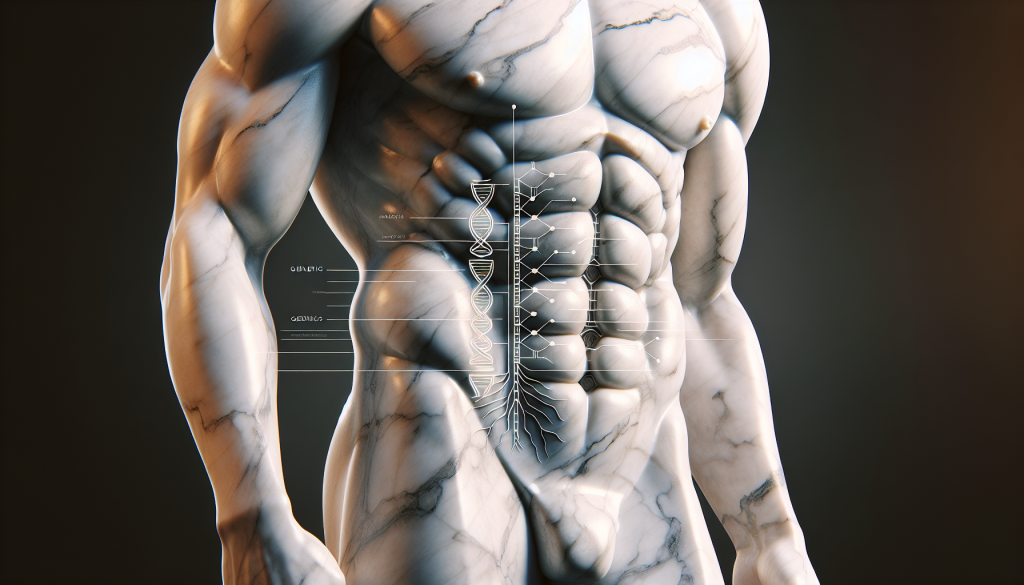Are you curious about the role genetics play in achieving those coveted six-pack abs? Many people wonder if their genetic makeup affects their ability to develop a strong, defined core. Well, we’re here to shed some light on the subject. In this article, we’ll explore the commonly asked questions surrounding the connection between genetics and getting a six-pack. So, sit back, relax, and let’s uncover the truth together!

Understanding Genetics and its Impact on Six-Pack Abs
Basics of Genetics
Genetics is the study of heredity and how traits are passed down from one generation to another through genes. These genes, composed of DNA, contain the instructions for building our bodies and determining various characteristics, including muscle definition and body fat distribution. Understanding the basics of genetics is essential in comprehending how genetics impact the development of six-pack abs.
Genetic Factors Affecting Muscle Definition
When it comes to muscle definition, genetics can play a significant role. The composition of muscle fibers can vary from person to person, and this genetic variation can affect how easily an individual can develop defined abdominal muscles. People possess two main types of muscle fibers: slow-twitch (Type I) and fast-twitch (Type II) fibers.
While slow-twitch fibers are better suited for endurance activities, fast-twitch fibers are responsible for explosive movements and strength. Genetic variations determine the ratio of these fibers in an individual’s muscles. Those with a higher proportion of fast-twitch fibers may find it easier to build muscle definition and achieve a six-pack appearance.
Influence of Genetics on Body Fat Distribution
The distribution of body fat is also influenced by genetics. Some individuals may naturally store more fat in the abdominal area, making it more challenging to achieve visible abs. Genetic factors determine where fat is stored in the body, with variations in genes affecting fat storage in subcutaneous (under the skin) and visceral (around the organs) fat.
This genetic predisposition for body fat distribution can influence the appearance of six-pack abs. Those who genetically store more fat in the abdominal region may need to put in additional effort to reduce body fat percentage and reveal their abs.
Genetic Predisposition for Muscle Size and Strength
In addition to muscle definition, genetics can also affect muscle size and strength. While consistent training and proper nutrition are crucial for building muscle mass, some individuals may have a genetic advantage when it comes to muscle development. Genetic variations can influence factors such as muscle fiber size, hormone levels, and muscle recovery, all of which contribute to muscle size and strength.
Understanding your genetic predisposition for muscle size and strength can help tailor your training and nutrition strategies to maximize your potential for achieving six-pack abs.
Nature vs. Nurture: The Debate on Genetics vs. Lifestyle
Importance of Lifestyle Factors
While genetics do play a significant role in the development of six-pack abs, it’s crucial to acknowledge the importance of lifestyle factors. Regardless of your genetic makeup, lifestyle choices such as exercise and nutrition greatly impact your ability to achieve a defined abdominal area.
Regular exercise, including targeted abdominal exercises, can improve muscle tone and definition. Alongside exercise, proper nutrition is essential for fueling your body and supporting muscle growth while maintaining a healthy body fat percentage.
Exercise and Nutrition for Six-Pack Abs
To optimize your chances of achieving six-pack abs, focus on both resistance training and cardiovascular exercise. Resistance training, including exercises such as planks, crunches, and leg raises, targets the abdominal muscles and helps build strength and definition. Cardiovascular exercise, such as running or cycling, helps burn calories and reduce overall body fat.
Proper nutrition is equally important. Ensure you’re consuming enough protein to support muscle repair and growth, while also incorporating a balanced diet rich in fruits, vegetables, whole grains, and healthy fats. Avoid excessive consumption of processed foods, sugary snacks, and alcohol, as they can hinder progress towards your six-pack goals.
Overcoming Genetic Limitations through Effort and Dedication
While genetics may present certain challenges, it’s crucial to remember that effort and dedication can overcome these limitations. With a consistent exercise routine, proper nutrition, and a positive mindset, individuals can surpass their genetic predispositions and achieve their desired level of muscle definition.
By focusing on maximizing your potential through lifestyle choices, you can enhance your genetics and attain the six-pack abs you’ve always desired.
Genetic Variations and their Effects on Six-Pack Abs
Muscle Fiber Type Composition
Genetic variations determine the composition of muscle fibers, which can have a significant effect on six-pack abs development. As mentioned earlier, the ratio of slow-twitch to fast-twitch muscle fibers varies among individuals. Those with a higher proportion of fast-twitch fibers may have a genetic advantage in terms of muscle definition and the ability to showcase abs.
Individuals with a high percentage of slow-twitch fibers may find it more challenging to develop visible abs, but with the right training program and consistent effort, they can still achieve their goals.
Metabolic Rate and Energy Expenditure
Metabolic rate, the rate at which the body burns calories, is influenced by genetic factors. Some individuals naturally have a higher metabolic rate, allowing them to burn calories more efficiently even at rest. A higher metabolic rate can contribute to achieving a lower body fat percentage, making it easier to showcase six-pack abs.
On the other hand, individuals with a lower metabolic rate may need to be more mindful of their calorie intake and make additional efforts to create a calorie deficit for fat loss.
Hormonal Factors and Genetic Variations
Hormonal factors, such as testosterone and growth hormone levels, also contribute to muscle development and the ability to achieve six-pack abs. Genetic variations can influence hormone production and sensitivity to these hormones, affecting muscle growth and fat loss.
Understanding your hormonal profile can provide insights into potential genetic advantages or limitations in achieving visible abs. Consultation with a healthcare professional or certified fitness expert can help determine the most effective strategies based on your genetic variations.
Genetic Differences in Muscle Recovery and Growth
Genetic variations can impact muscle recovery and growth rates. Some individuals may have a genetic advantage in terms of muscle repair and growth, allowing for more efficient progress in their six-pack abs journey. Factors such as protein synthesis, nutrient absorption, and inflammation response can differ genetically, influencing how quickly and effectively muscles recover and grow.
While genetic differences exist, consistent training, proper nutrition, and adequate rest can optimize muscle recovery and growth, regardless of genetic limitations.
The Role of Genetics in Body Fat Percentage for Six-Pack Abs
Genetic Influence on Fat Metabolism
Genetics influences various aspects of fat metabolism, which can impact body fat percentage and the visibility of six-pack abs. Some individuals genetically possess a higher capacity for metabolizing fat efficiently, making it easier for them to achieve a lower body fat percentage.
In contrast, genetic variations may predispose certain individuals to store and retain fat more readily, which can make it more challenging to reduce body fat levels and reveal their abs. However, lifestyle choices, such as a healthy diet and regular exercise, can help overcome these genetic influences and improve overall body composition.
Distribution of Subcutaneous vs. Visceral Fat
Genetic factors also determine the distribution of fat in the body. Subcutaneous fat is found just beneath the skin and can contribute to a softer appearance, while visceral fat is located around the organs and may not be as visible.
Individuals with a genetic predisposition for storing more subcutaneous fat in the abdominal region may need to focus on reducing overall body fat percentage to reveal their abs. By incorporating a combination of cardiovascular exercise and proper nutrition, individuals can achieve a balance between reducing both subcutaneous and visceral fat, promoting the visibility of their abdominal muscles.
Genetic Factors Influencing Basal Metabolic Rate
Basal metabolic rate (BMR) is the number of calories the body burns at rest. Genetic factors influence BMR, with variations leading to individual differences in energy expenditure. Some individuals have a naturally higher BMR, which results in a greater calorie burn even when not engaged in physical activity.
Understanding your genetic predisposition for BMR can help guide your approach to calorie intake and expenditure, supporting your goals of achieving visible abs. Through a combination of exercise, proper nutrition, and mindful portion control, individuals can work with their genetics to optimize their body fat percentage and enhance muscle definition.

Common Misconceptions About Genetics and Six-Pack Abs
Genetics as an Excuse for Lack of Progress
A common misconception is that genetics alone determine the ability to develop six-pack abs. While genetic factors do play a role, using genetics as an excuse for lack of progress can be counterproductive. It’s essential to focus on the factors within your control, such as exercise, nutrition, and consistency.
By acknowledging the influence of genetics while emphasizing personal effort, individuals can overcome perceived limitations and achieve their desired level of muscle definition.
Genetic Advantage vs. Hard Work
While some individuals may have a genetic advantage when it comes to muscle development and achieving visible abs, hard work and dedication are crucial components. Even those with favorable genetics need to commit to a consistent training routine, proper nutrition, and a healthy lifestyle to optimize their results.
Genetics may provide a head start, but it is sustained effort and consistent habits that ultimately lead to success in attaining and maintaining six-pack abs.
Overcoming Genetic Disadvantages
Individuals with genetic predispositions that make achieving visible abs more challenging should not become discouraged. With the right approach to training, nutrition, and lifestyle, it is possible to overcome genetic disadvantages and achieve significant progress.
Patience, perseverance, and a positive mindset are key to overcoming obstacles and working towards individual goals. Celebrate each milestone along the way, knowing that progress is possible regardless of genetic variations.
Exploring Strategies to Maximize Six-Pack Abs Potential
Finding the Right Training Program
To maximize the potential for six-pack abs, finding the right training program is essential. It should include a combination of resistance training that targets the abdominal muscles, as well as cardiovascular exercises to reduce overall body fat. Consulting with a certified fitness professional can help you tailor a program that suits your genetic make-up and specific goals.
Remember that consistency is key, so be sure to follow your training program consistently to see the desired results.
Optimizing Nutrition for Muscle Definition
Proper nutrition is crucial in optimizing muscle definition and achieving six-pack abs. It’s essential to consume enough protein to support muscle repair and growth, as well as incorporate a balanced diet rich in fruits, vegetables, whole grains, and healthy fats.
Be mindful of portion sizes and avoid excessive calorie consumption, especially from processed foods and sugary snacks. By fueling your body with the right nutrients, you can support muscle development and maintain a healthy body fat percentage.
Supplementation for Genetic Support
While not a substitute for proper nutrition, certain supplements may support your genetic potential for six-pack abs. Consult with a healthcare professional or registered dietitian to identify which supplements, if any, may be suitable for your needs.
Supplementation should always be approached with caution, ensuring to choose reputable brands and follow recommended dosages. Remember that supplements are not a magic solution but can complement your overall fitness journey.
Importance of Consistency and Patience
Maximizing your six-pack abs potential requires consistency and patience. Results do not happen overnight and may vary depending on your genetic makeup and other individual factors. Stick to your training program, maintain a balanced diet, and be patient with your body’s natural progression.
By staying consistent and allowing your body time to respond to your efforts, you will increase your chances of achieving visible six-pack abs.

The Influence of Genetics on Visible Abdominal Muscles
Genetic Factors Affecting Abdominal Muscle Shape
Genetic variations can influence the shape and structure of abdominal muscles. While the number of muscle fibers is primarily determined by genetics, factors such as muscle insertions and attachments can impact abdominal muscle appearance.
Some individuals may naturally have more prominent abs or deeper separations between muscle groups due to genetic factors. However, even individuals with less genetically pronounced abdominal muscles can still achieve a well-defined, aesthetic appearance through targeted exercises and overall reduction in body fat percentage.
Determining Ideal Body Fat Percentage for Abs
The ideal body fat percentage required to reveal visible abs varies among individuals due to genetic factors. Striving for extremely low body fat percentages is not necessarily advisable, as it can have negative health implications.
Determining the ideal body fat percentage for your abs can be done in consultation with a healthcare professional or experienced fitness expert. They can assess your overall health, body composition, and genetic factors to guide you towards a healthy and realistic goal.
Genetic Variations in Abdominal Muscle Separation
The separation of abdominal muscles, also known as muscle definition or “the lines,” can be influenced by genetic variations. Some individuals may have naturally wider separations between their abdominal muscles, leading to a more distinct appearance when body fat levels are low.
While the degree of separation may be partly determined by genetics, it is important to note that overall body fat percentage plays a significant role. Through consistent exercise, proper nutrition, and fat loss, individuals can enhance the visibility of their abdominal muscle separations.
Athletes, Genetics, and Six-Pack Abs
Genetics of Elite Athletes with Six-Pack Abs
Elite athletes often possess a combination of genetic attributes that contribute to their lean physique and visible six-pack abs. While genetics alone do not guarantee athletic success or a chiseled midsection, they can provide a foundation for optimized performance and aesthetics.
Traits such as a higher proportion of fast-twitch muscle fibers, favorable hormone profiles, and efficient energy metabolism may be more prevalent in elite athletes. However, it’s important to recognize that their achievements also stem from years of dedicated training, proper nutrition, and a focus on overall health and fitness.
Role of Genetics in Athletic Performance
Genetics significantly impact athletic performance, and the development of six-pack abs is no exception. Factors such as muscle fiber composition, metabolic rate, and hormone levels can affect an individual’s athletic potential. Genetic variations can contribute to differences in strength, power, endurance, and body composition among athletes.
While genetics form the baseline, consistent training, proper nutrition, and mental fortitude are vital in honing athletic abilities and achieving optimal results.
Balancing Genetics and Training for Optimal Results
To achieve optimal results in terms of both aesthetic appearance and athletic performance, it is essential to strike a balance between genetics and training. While genetic attributes may provide advantages or limitations, training can help individuals maximize their potential and transcend their genetic predispositions.
Consulting with a certified fitness professional who understands the interplay between genetics and training can help create a tailored program that aligns with your genetic profile. By leveraging genetics and staying committed to your training regimen, you can enhance your chances of achieving six-pack abs and overall athletic success.

Nature’s Blueprint: How Genetics Design our Bodies
Understanding Genetic Traits and Variations
Our bodies are products of genetic traits and variations that have accumulated over generations. These genetic traits determine various characteristics, including physical appearance, muscle development, and body composition. Traits can be inherited from both parents, resulting in a unique combination that makes each individual genetically distinct.
Understanding genetic traits and variations can provide insight into why certain individuals may have a greater predisposition towards developing six-pack abs, while others may face more challenges. Embracing the uniqueness of our genetic makeup allows us to work with what we have and optimize our personal fitness goals.
Inheritance Patterns and DNA Influence
Inheritance patterns follow specific rules that govern the passing down of genetic information from parents to offspring. DNA, the building block of our genes, carries this hereditary information and influences various aspects of our bodies.
Genetic information is grouped into chromosomes, with each parent contributing one set of chromosomes to their offspring. Within these chromosomes, genes are located, which contain the instructions for building proteins that determine our physical traits. The interplay between inherited DNA and environmental factors influences our physical development, including the potential for six-pack abs.
The Complexity of Genetic Interactions
Genetic interactions are incredibly complex, with numerous genes and environmental factors influencing our physical attributes. Genes do not act in isolation but instead interact with one another, creating a complex network of genetic interactions.
These interactions can result in countless variations and combinations, leading to differences in muscle development, body fat distribution, and overall physique. It’s essential to recognize that genetics are just one piece of the puzzle, and other factors, such as lifestyle and environmental influences, also play a significant role in shaping our bodies.
Embracing Individuality: Genetics and Personal Fitness Goals
Setting Realistic Expectations
When it comes to achieving six-pack abs, setting realistic expectations is crucial. Understand that your genetic makeup, along with other individual factors, will influence the rate and extent of your progress. Comparing yourself to others may lead to frustration or discouragement, as everyone’s genetic blueprint is unique.
Focus on your personal goals and celebrate the progress you make along the way. Embrace your individuality and work towards being the best version of yourself, rather than trying to conform to someone else’s genetic characteristics.
Working with Genetic Attributes
Instead of viewing genetics as a limitation, consider how you can work with your genetic attributes to optimize your results. Understanding your genetic predispositions and consulting with professionals who can provide expert guidance can help you tailor your training, nutrition, and overall approach to achieving six-pack abs.
By leveraging your genetic attributes, you can design a fitness program that aligns with your body’s unique characteristics, ultimately leading to better results and overall satisfaction.
Focusing on Overall Health and Fitness
While visible six-pack abs may be a desirable aesthetic goal, it’s important to remember that overall health and fitness should be the primary focus. Genetics influence not only physical appearance but also factors such as metabolism, hormone levels, and overall well-being.
By adopting a holistic approach to fitness, which includes regular exercise, proper nutrition, stress management, and adequate sleep, you can optimize your health and well-being. Appreciate the journey towards achieving six-pack abs as part of a broader commitment to your overall health and fitness, embracing the positive impact that genetics can have on your personal growth.
In conclusion, genetics certainly play a significant role in the development of six-pack abs. Genetic factors such as muscle fiber composition, body fat distribution, metabolic rate, and muscle recovery can impact an individual’s potential for achieving visible abs. However, lifestyle choices, including exercise, nutrition, consistency, and dedication, also play a crucial role in overcoming genetic limitations and maximizing one’s potential. By understanding your genetic predispositions, working with your genetic attributes, and focusing on overall health and fitness, you can enhance your chances of achieving the six-pack abs you desire while embracing your individuality.





